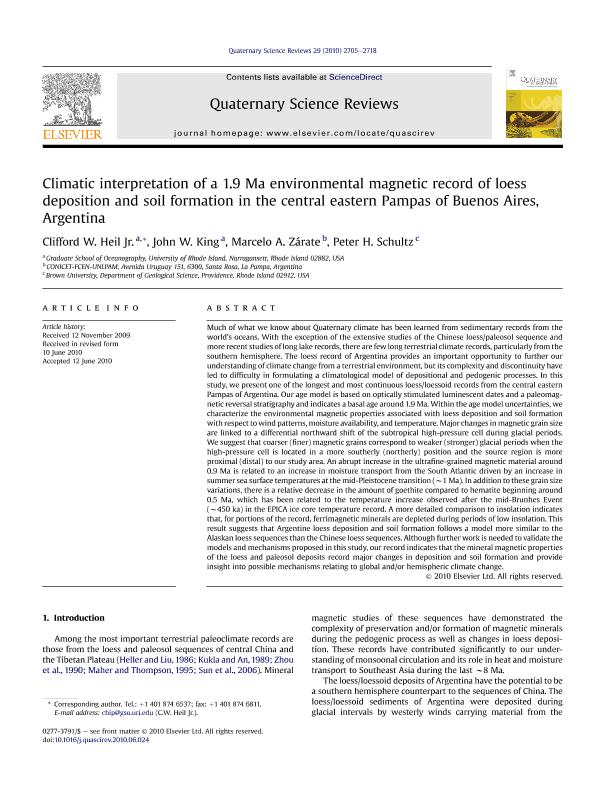Artículo
Climatic interpretation of a 1.9 Ma environmental magnetic record of loess deposition and soil formation in the central eastern Pampas of Buenos Aires, Argentina
Fecha de publicación:
09/2010
Editorial:
Pergamon-Elsevier Science Ltd
Revista:
Quaternary Science Reviews
ISSN:
0277-3791
Idioma:
Inglés
Tipo de recurso:
Artículo publicado
Clasificación temática:
Resumen
Much of what we know about Quaternary climate has been learned from sedimentary records from the world's oceans. With the exception of the extensive studies of the Chinese loess/paleosol sequence and more recent studies of long lake records, there are few long terrestrial climate records, particularly from the southern hemisphere. The loess record of Argentina provides an important opportunity to further our understanding of climate change from a terrestrial environment, but its complexity and discontinuity have led to difficulty in formulating a climatological model of depositional and pedogenic processes. In this study, we present one of the longest and most continuous loess/loessoid records from the central eastern Pampas of Argentina. Our age model is based on optically stimulated luminescent dates and a paleomagnetic reversal stratigraphy and indicates a basal age around 1.9 Ma. Within the age model uncertainties, we characterize the environmental magnetic properties associated with loess deposition and soil formation with respect to wind patterns, moisture availability, and temperature. Major changes in magnetic grain size are linked to a differential northward shift of the subtropical high-pressure cell during glacial periods. We suggest that coarser (finer) magnetic grains correspond to weaker (stronger) glacial periods when the high-pressure cell is located in a more southerly (northerly) position and the source region is more proximal (distal) to our study area. An abrupt increase in the ultrafine-grained magnetic material around 0.9 Ma is related to an increase in moisture transport from the South Atlantic driven by an increase in summer sea surface temperatures at the mid-Pleistocene transition (∼1 Ma). In addition to these grain size variations, there is a relative decrease in the amount of goethite compared to hematite beginning around 0.5 Ma, which has been related to the temperature increase observed after the mid-Brunhes Event (∼450 ka) in the EPICA ice core temperature record. A more detailed comparison to insolation indicates that, for portions of the record, ferrimagnetic minerals are depleted during periods of low insolation. This result suggests that Argentine loess deposition and soil formation follows a model more similar to the Alaskan loess sequences than the Chinese loess sequences. Although further work is needed to validate the models and mechanisms proposed in this study, our record indicates that the mineral magnetic properties of the loess and paleosol deposits record major changes in deposition and soil formation and provide insight into possible mechanisms relating to global and/or hemispheric climate change.
Palabras clave:
Magnetic Susceptibility
,
Loess
,
Paleosols
,
Pampas
Archivos asociados
Licencia
Identificadores
Colecciones
Articulos(INCITAP)
Articulos de INST.D/CS D/L/TIERRA Y AMBIENTALES D/L/PAMPA
Articulos de INST.D/CS D/L/TIERRA Y AMBIENTALES D/L/PAMPA
Citación
Heil, Clifford W.; King, John W.; Zárate, Marcelo Arístides; Schultz, Peter H.; Climatic interpretation of a 1.9 Ma environmental magnetic record of loess deposition and soil formation in the central eastern Pampas of Buenos Aires, Argentina; Pergamon-Elsevier Science Ltd; Quaternary Science Reviews; 29; 19-20; 9-2010; 2705-2718
Compartir
Altmétricas




